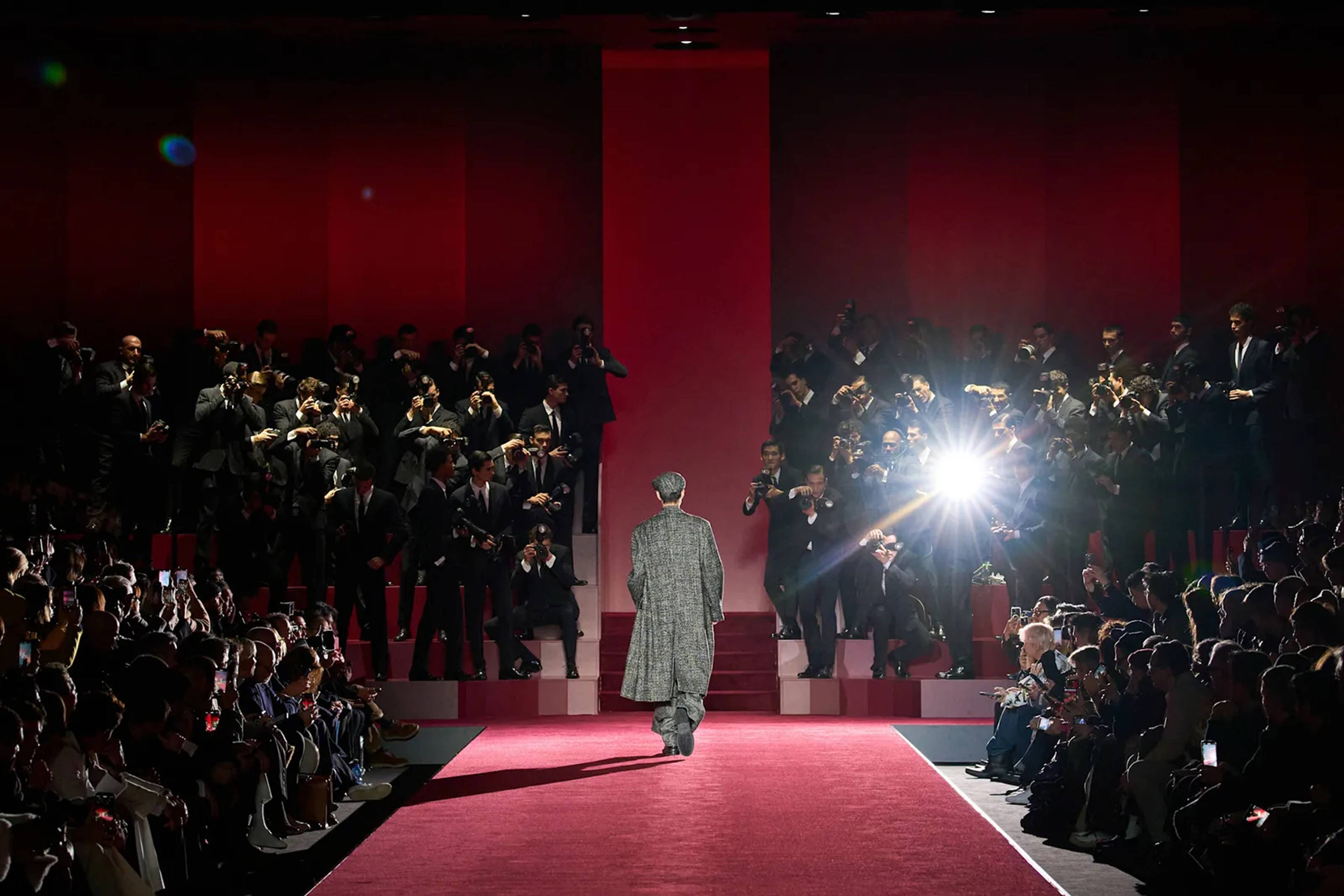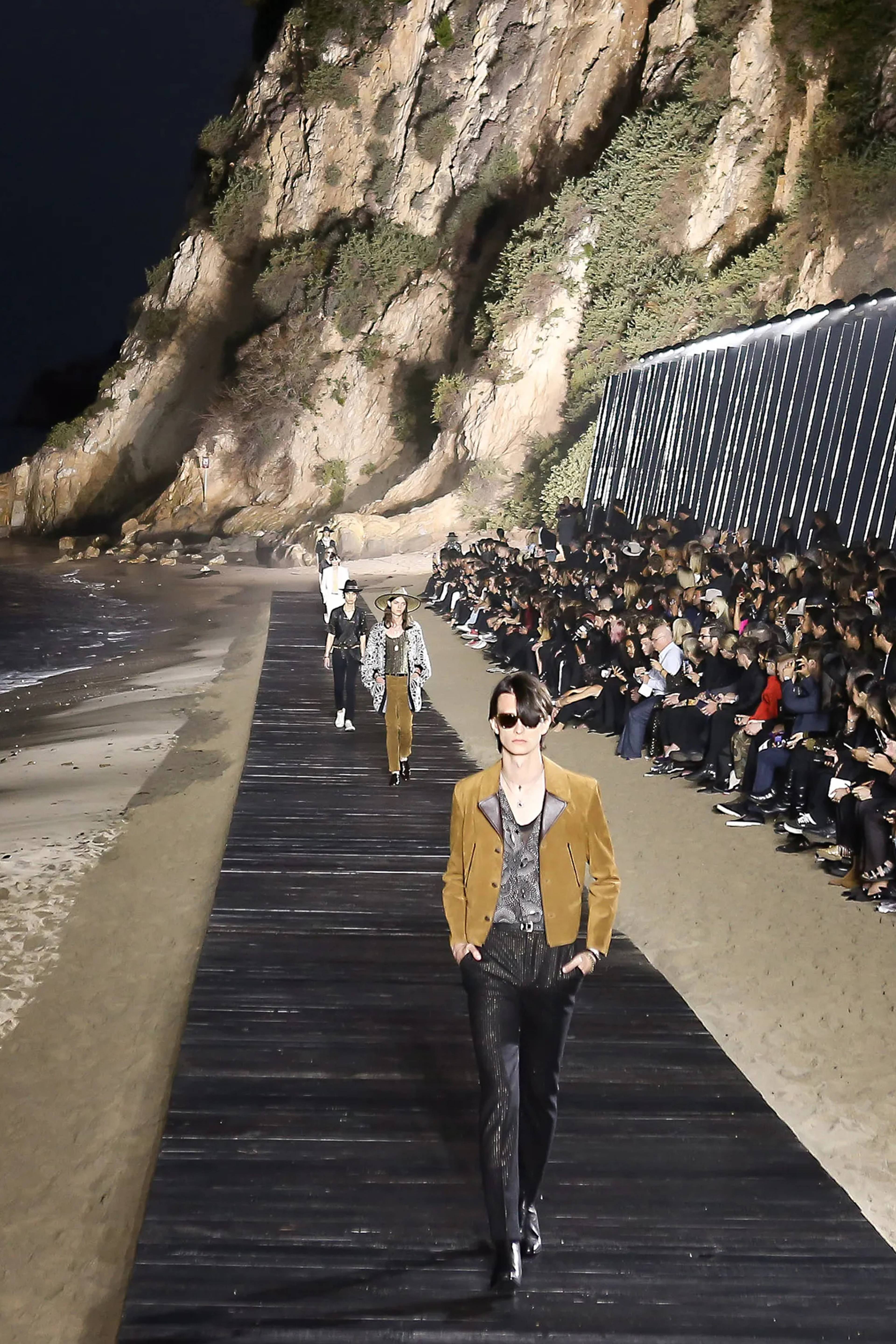This month, I dealt myself a recurring nightmare. I watched David Robert Mitchell’s 2014 horror film, It Follows, mainly because it’s the basis of a chapter in the US critic Sianne Ngai’s Theory of the Gimmick (2020), in which she compares the film’s sexually transferrable, shapeshifting zombie-killer to transferrable debt.
I’m a big Ngai fan, but I seldom watch horror. I have the kind of brain that’s susceptible, and the cheesiest movie can prey on my mind for weeks. If I thought It Follows’ inclusion in a work of neo-Marxist theory was the best way to neutralize the scare, I was wrong. Instead, it got mashed up in my imagination with “Baie des Anges,” the video for Celine’s Summer 2022 collection, in which stony-faced models march down some imaginary version of Nice’s main drag, as relentlessly as the It Follows demon, to the sinister heartbeat of Can’s “Vitamin C” (1972), which had somehow, for me, become the track to Mitchell’s movie. And this all made me think: Why the catwalk?
The catwalk was once very private. Now, it’s both public and private again. Initially designed to show clothes to members of the public – aka individual “private” buyers – “shows” now only show “privately” to trade: fashion eds, store buyers, and the occasional front-row celeb who has advertised the brand or, by being there, aligns with its. But shows have also become public again through their dissemination online, and this has restored the walk to the cat. Initially an innovation designed to show clothes on moving bodies, 20th century catwalk shows were seen by the general public only via the static medium of photography in newspapers and magazines. Now that every show’s replayed on YouTube or TikTok, or the designers’ own websites, the catwalk has, again, become something publicly moving.
Catwalking is a very specific kind of movement. A model “walks” for a designer, and it’s a particular walk (in Kevin Macdonald’s 2023 documentary, High and Low, John Galliano teaches a very young Kate Moss how to walk for her first show: “He said, like, put your hips, your pelvis forward and lean back …”). In the (inevitably) French vocabulary of the fashion show, models walk in what’s called a défilé. It literally means a line, a march, a parade, and its primary definitions in dictionaries are (apart from fashion) military ones (un défilé militaire). What was originally called a “fashion parade” was invented as the parades of 19th-century empires became the nationalist celebrations of the 20th. Could some of the designers who refused to dress the Trumps for their recent inauguration find a way of displaying clothes that decouples them from displays of power?
Garments look great when models “walk,” but it’s only one thing bodies do. We sit in our clothes, dance, sleep, cook, dine, work. We don’t often do these things in lines.
Military and fashion défilés are both composed of ranks of people who do the same thing at the same time and who don’t interact. Even in the most avant-garde fashion shows, models walk alone. It’s something to do with modernism: an urban encounter, passing on a metro platform. It’s something to do with capitalist individuation, what Pierre Bourdieu called “difference,” in which taste is weaponized as a separator that alienates us from each other. It’s something to do with the way many big fashion shows are produced. Ultimately liquid labor, models are hired from all over the world. Many have never met before, an alienation the catwalk is designed to preserve.
On the catwalk, models don’t speak. To the audience. To each other. The message of the show has to be decoded, and the clothing must speak for itself. What is it about a voice that would ruin things? Is it contact? With the audience? With each other? Okay, garments look great when models “walk,” but it’s only one thing bodies do. We sit in our clothes, dance, sleep, cook, dine, work. We don’t often do these things in lines. We don’t always do these things alone.
There have been attempts to break the fashion-show formula: Saint Laurent Spring/Summer 2020 Men’s Collection took place on a beach, Karl Lagerfeld’s 2007 Fall/Winter collection (famously) on the Great Wall of China, and Officine Generale’s recent Fall/Winter 2025 show at the Paris bistro Le Rouquet (which, incidentally, was also the venue for Saint Laurent’s Winter 24 ad campaign). But, while the setting changed, the walk did not.
Saint Laurent, Spring/Summer 2020, Paradise Cove, Malibu
In a world where rhizomatic structures have superseded the fast-forward production lines of modernism, it follows that it’s time to rethink the catwalk. Where art is already diffusing binaries into the social and communal – as when Array Collective won the Turner Prize in 2021, from a shortlist entirely made up of artist collectives, with their installation of a Belfast pub – isn’t it time to think up more expansive ways of seeing clothes?
Alienated, but at least self-consciously, this January’s Fall/Winter 2025 Dolce & Gabbana Menswear show staged models as immaculately dressed, La Dolce Vita-era paparazzi, posed in a mob, papping the audience. They didn’t interact with each other or the viewers, and they didn’t cross the catwalk’s fourth wall, but they did make a gesture toward awareness that it’s there at all, yet to be crossed. Who’s going to do it?



